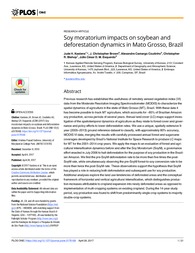Soy moratorium impacts on soybean and deforestation dynamics in Mato Grosso, Brazil.
Soy moratorium impacts on soybean and deforestation dynamics in Mato Grosso, Brazil.
Author(s): KASTEN, J. H.; BROWN, J. C.; COUTINHO, A. C.; BISHOP, C. R.; ESQUERDO, J. C. D. M.
Summary: Abstract - Previous research has established the usefulness of remotely sensed vegetation index (VI) data from the Moderate Resolution Imaging Spectroradiometer (MODIS) to characterize the spatial dynamics of agriculture in the state of Mato Grosso (MT), Brazil. With these data it has become possible to track MT agriculture, which accounts for ~85% of Brazilian Amazon soy production, across periods of several years. Annual land cover (LC) maps support investigation of the spatiotemporal dynamics of agriculture as they relate to forest cover and governance and policy efforts to lower deforestation rates. We use a unique, spatially extensive 9-year (2005?2013) ground reference dataset to classify, with approximately 80% accuracy, MODIS VI data, merging the results with carefully processed annual forest and sugarcane coverages developed by Brazil?s National Institute for Space Research to produce LC maps for MT for the 2001?2014 crop years. We apply the maps to an evaluation of forest and agricultural intensification dynamics before and after the Soy Moratorium (SoyM), a governance effort enacted in July 2006 to halt deforestation for the purpose of soy production in the Brazilian Amazon. We find the pre-SoyM deforestation rate to be more than five times the post-SoyM rate, while simultaneously observing the pre-SoyM forest-to-soy conversion rate to be more than twice the post-SoyM rate. These observations support the hypothesis that SoyM has played a role in reducing both deforestation and subsequent use for soy production. Additional analyses explore the land use tendencies of deforested areas and the conceptual framework of horizontal and vertical agricultural intensification, which distinguishes production increases attributable to cropland expansion into newly deforested areas as opposed to implementation of multi-cropping systems on existing cropland. During the 14-year study period, soy production was found to shift from predominantly single-crop systems to majority double-crop systems.
Publication year: 2017
Types of publication: Journal article
Observation
Some of Embrapa's publications are published as ePub files. To read them, use or download one of the following free software options to your computer or mobile device. Android: Google Play Books; IOS: iBooks; Windows and Linux: Calibre.
Access other publications
Access the Agricultural Research Database (BDPA) to consult Embrapa's full library collection and records.
Visit Embrapa Bookstore to purchase books and other publications sold by Embrapa.

